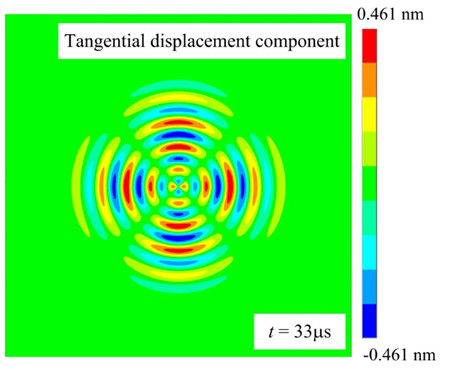Peking University, Nov. 2, 2016: Recently, Professor Li Faxin’s group in the College of Engineering, Peking Universitymade a breakthrough in the field of nondestructive testing (NDT) and structural health monitoring (SHM). They proposed a face-shear (d24) piezoelectric transducer, which can excite single-mode shear-horizontal wave (SH0) in plate structures and selectively receive SH0 wave by filtering the Lamb waves. This work was just published as a Letter in the IOP journal Smart Materials and Structures(http://dx.doi.org/10.1088/0964-1726/25/11/11LT01. The first author is Mr. Miao Hongchen , a Ph.D. student in the college of Engineering who started his studies in Year 2012.
Ultrasonic guide wave inspection is an advanced technique in the field of NDT/SHM. Compared with bulk waves, guided wave has less attenuation and thus can propagate for a long distance, very promising for quick defect detection and monitoring. The guided waves in plates and pipes had been intensively studied as they are relatively simple and useful in practical applications. Take the guided waves in plates as an example, there exist both Lamb waves and shear-horizontal waves in plates. Lamb waves are easy to excite and sense, but they are dispersive, which limits their propagation distance. Meanwhile, mode transfer occurs when Lamb wave encounters defects or structure boundaries, which makes the received signal rather complicated. The fundamental shear-horizontal (SH0) wave is the only non-dispersive wave mode in plates, it can hardly transfer to other wave mode during propagation, which makes the signal processing very simple. However, the single-mode SH0 wave is rather difficult to excite.
In 1990s, single-mode SH0 wave had been excited by using the electromagnetic acoustic transducers (EMAT). EMAT works in a non-contact mode, which is promising for high-temperature cases. However, the energy conversion efficiency of the EMAT is about 1-2 orders lower than the piezoelectric transducers. Thus, EMAT must be operated using high-power amplifiers, which makes the detection system bulky and heavy, not suitable for SHM. In recent years, some scholars have attempted to excite SH0 wave using piezo-fiber based composites or piezoelectric single crystals, while the single mode SH0 waves still cannot be excited.
Professor Li’s group firstly realized the d36 face-shear mode in piezoelectric ceramics (APL,107, 122902, 2015), then they excited SH0 waves in plates by using d36 mode transducers. Unfortunately, the single-mode SH0 wave still cannot be excited (JAP, 119, 174101, 2016). In late 2015, they changed the strategy. By using an in-plane poled piezoelectric ceramics and applying electric field along another in-plane direction, they realized pure face-shear (d24) mode in piezoelectric ceramics. Then, by using the d24 mode piezoelectric wafer as actuators, they successfully excited single-mode SH0 wave in an aluminum plate.
The d24 piezoelectric transducer can also act as a selective SH0 wave sensor by filtering the Lamb waves. Professor Li’s group further developed an omni-directional SH0 wave transducer in plate using circular array of d24 piezoelectric wafers, and excited single-mode fundamental torsional waves T(0,1) in pipes using ring array of d24 piezoelectric wafers. These two works are still under review. The significance of this work (SMS 2016) is that it provided an easy and reliable way to excite SH0 wave in plates, which could greatly promote the application of SH0 waves in NDT/SHM. Meanwhile, as it is cost-effective and does not external load when mounting, the d24 mode piezoelectric transducer is expected to dominate the SHM system of long-distance pipes in future.
This work had been paid more attention to and highly appreciated by scholars in the field of NDT/SHM. On the 1st International Workshop of Structural Health Monitoring for Railway System (Qingdao, China, Oct.12-14, 2016), this work was granted with the Meritorious Paper Award (first prize). The Chairman of the Review Committee is Professor Fu-Kuo Chang, Stanford University, who is also the Editor-in-chief of the international journal Structural Health Monitoring. The committee includes Professor Peter Cawley, Fellow of Royal Society and Fellow of Royal Society of Engineering, head of Mechanical Engineering, Imperial College, and other renowned scholars in NDT/SHM. The Chair Professor M. Ruzzene at Aerospace Engineering, Georgia Tech Inst appraised this work to be “very good, very important”.
Simulated wavefield of the SH0 wave excited by a d24 face-shear piezoelectric wafer
Edited by: Zhang Jiang
Source: College of Engineering
